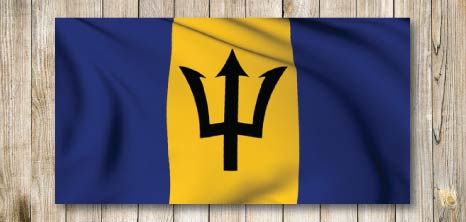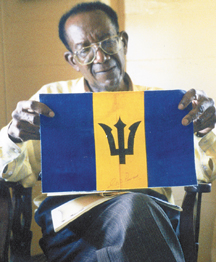|
The National Flag of BarbadosThe National Flag of Barbados was officially adopted on November 30th 1966 when the island became independent. It is composed of three vertical panels with gold on the inside panel and ultra marine on the two outer panels. In the middle of the gold panel is a broken Trident in black. The blue represents the sea and sky of the island and the gold our sand on the beaches. The broken Trident is representative of a mythical sea god Neptune whose symbol appears in the old Seal of the colony which shows Britannia holding a trident. The seal of the colony was replaced by our coat of arms after independence. The Trident is broken representing the break from the United Kingdom of historical and constitutional ties after the island became independent.
Click here to see the flags Code of Etiquette
Judging of the competition for the Government was made up of a 7 panel group including Major Leonard Banfield, Mr. Maurice Cave, Mr Neville Connell, Mrs. Enid Lynch, Mrs B. Ward being chaired by Mr. Bruce St. John.
Mr. Prescod attended the following schools: • St. Barnabas Boys School located in Barbados • Temple University (USA) gaining a Master of education degree majoring in Art Education
On returning to Barbados he taught at the Parkinson Secondary School and served as an education offices from September 1977 until he retired in February 1987. He passed away on the 12th November, 2003 at the age of 77 of a short illness. Other Flags of BarbadosFollowing are a number of other important and past flags of Barbados.
|
|||||||||||||||||||||||||||||||||||||||||||||||||||||||||||||||||||||||||||
| 1. Dimensions of the Barbados National Flag | |
|
The dimensions of the Barbados National Flag shall be in the following proportions:-
|
|
| 2. How to Display the Flag: | |
| (i) |
The Flag should be of regulation appearance. It should not be faded or bleached and a torn flag should be repaired before being hoisted.
|
| (ii) |
The flag-mast, when erected on land, should be placed upright and should be in a central or conspicuous place. On buildings, however, the flag-mast may either be placed in an upright position on the roof or fixed at an angle on the front of the building or from a balcony.
|
| (iii) |
The flag-mast should be painted white.
|
| (iv) |
No other flag may be flown above the Barbados flag. When several flags are flown on one halliard the Barbados flag is placed at the peak. when the Flags of two or more nations are displayed together they are to be flown from separate staffs of the same height and all flags should be, as far as possible, of the same size. The flag of one nation should not be displayed above that of another.
|
| (v) |
No other flag, colour, standard, ensign or other emblem should be displayed above or to the right of the National Flag, i.e. the observer's left facing it.
|
| (vi) |
When two flags are placed against a wall with crossed staffs, the Barbados Flag should be at the right - i.e. to the observer's left facing the flags – and its staff should be in front of the staff of the other flag. When a number of flags are grouped and displayed from staffs the Barbados Flag should be at the Centre and at the highest point of the group.
|
| (vii) |
When the National Flag is flown with other flags it should be the first to be hoisted and the last to be lowered while the other flags are flying or being hoisted.
|
| (viii) |
The Flag may be displayed flat above and behind the speaker in a church or in an auditorium. If on a staff, it should be at the right off the speaker as he faces the congregation or audience. Other flags should be at the speaker's left. If the flag is displayed on a staff elsewhere than on a platform or chancel it should be at the right of the audience or congregation as they face the speaker. It should not cover a speaker's desk or be draped in front of a platform.
|
| (ix) |
Except on a day of special significance the national Flag shall not be flown on a motor car without the permission of the minister.
|
| (x) |
Where the National Flag is flown on a motor car in accordance with paragraph.
|
| (ix) |
It shall be affixed to a small staff erected on the right front fender of the motor car so that the Flag should be above the bonnet of that motor car.
|
| (xi) |
A citizen may fly the flag on a day of special significance provided he flies the flag from an upright staff on the front of his dwelling or place of business.
|
| 3. When to Display the Flag | |
| (i) |
The National Flag will be flown every day from the Public Buildings, Trafalgar Square, from 6 a.m. to 6 p.m. It may be flown daily from Government buildings and schools when they are in session, and places of business.
|
| (ii) |
The National Flag should not be flown after 6:00 p.m. except inside a building. However, on important ceremonial occasions the flag may be flown in the open after 6:00 p.m. when it should be floodlit if possible.
|
| 4. The Flag in a Parade | |
|
When carried with another flag or flags the Flag of Barbados should be held on the marching right or in front of the centre of the line of flags. When the flag is passing in a parade or in a review or during the ceremony of hoisting or lowering of the Flag, all persons present should face the Flag and stand at attention.
|
|
| 5. The Flag at Half-Staff | |
| (i) |
The National Flag is flown at half-staff in mourning.
|
| (ii) |
When flown at half-staff the Flag should first be raised to the peak and then lowered to half staff. The flag should again be raised to the peak before it is lowered.
|
| (iii) |
By half-staff is meant the lowering of the flag by its own depth from the peak of the staff. The decision on the occasions on which the flag should be flown at half-staff would rest with the Cabinet.
|
| 6. Prohibited Uses of the Flag | |
| (i) |
The Flag should not be dipped to any person or thing, except in accordance with maritime practice.
|
| (ii) |
The Flag should never be flown with the trident inverted except as a signal of distress.
|
| (iii) |
The Flag should not be displayed on a float, motorcar or other vehicle or on a boat, except from a staff or masthead.
|
| (iv) |
The Flag should not have placed on it or attached to it any mark, insignia, letter, word, figure, design, picture or drawing.
|
| (v) |
The Flag should never be used as a receptacle. It should not be used to cover a statue or monument.
|
| (vi) |
The Flag should not be used for purposes of adornment or advertising. It should not be printed on, or reproduced on, articles of clothing or furniture.
|
| (vii) |
The Flag when on display should not be allowed to touch anything beneath it such as furniture, floors, trees, plants, vehicles, buildings, water or the earth.
|


 thousand entries were received and his design was chosen. For designing the flag Mr. Prescod was awarded the Gold Medal with and inscribed scroll from the Government. There was also a $500.00 cash prize given that was donated by the Advocate Company Ltd. a popular publisher of newspapers. Not only did he design the first flag but he is also credited with making the first flag after then Prime Minister
thousand entries were received and his design was chosen. For designing the flag Mr. Prescod was awarded the Gold Medal with and inscribed scroll from the Government. There was also a $500.00 cash prize given that was donated by the Advocate Company Ltd. a popular publisher of newspapers. Not only did he design the first flag but he is also credited with making the first flag after then Prime Minister 







